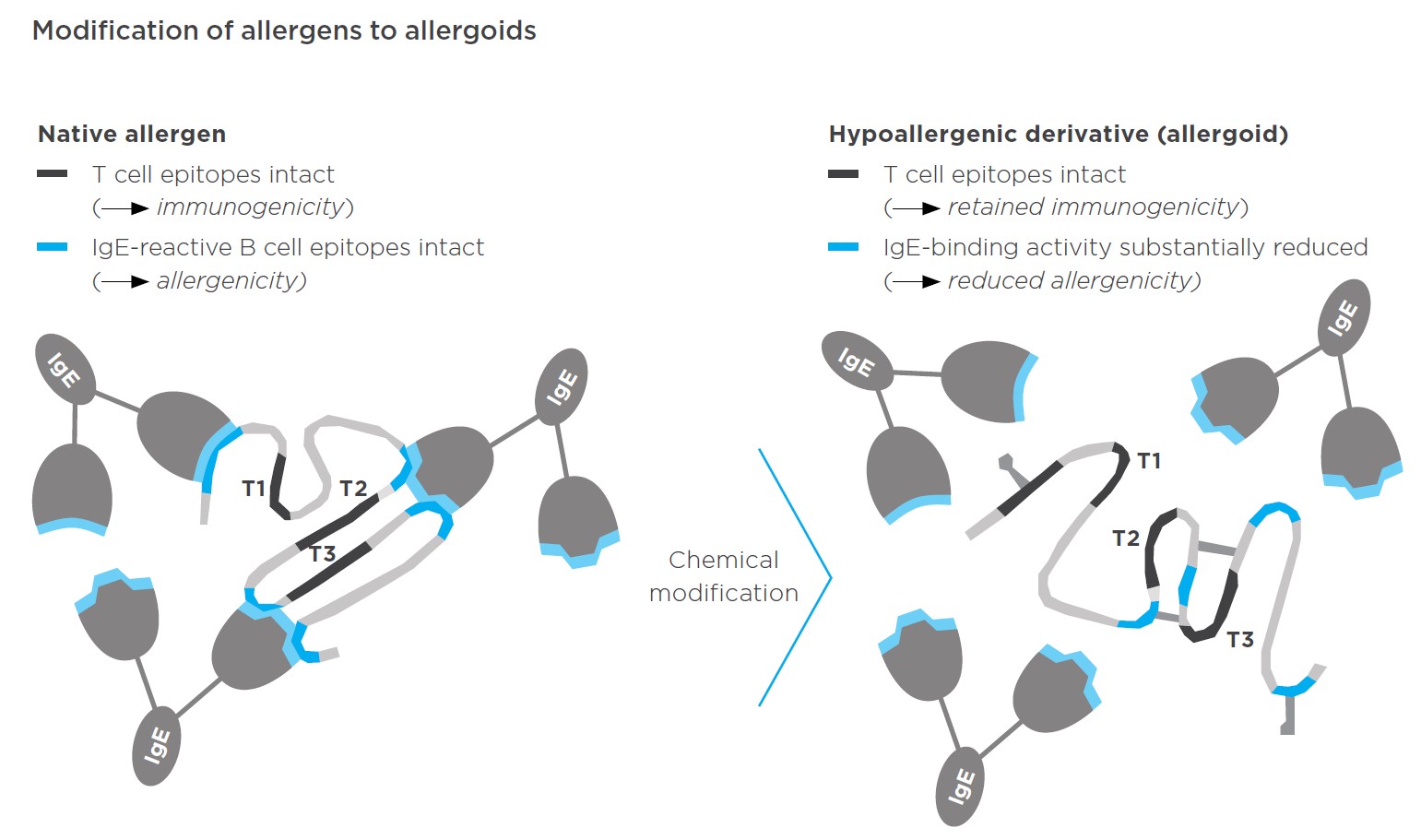Allergen Immunotherapy
Allergen immunotherapy - treat the cause of allergy
Allergen immunotherapy (AIT) is the only causal treatment for allergies to unavoidable allergens, such as pollen or mites. It involves the administration of increasing doses of the respective allergens, with the aim of modulating the immune system and ameliorating the allergic response.
In allergic patients, TH2 cells are predominant and trigger the production of immunoglobulin E (IgE). After sensitization, the IgE bound to the surface of the mast cells causes them to release histamine and other inflammatory mediators upon contact with the allergen. In addition, allergy patients show a relative low proportion of regulatory T cells (T-regs), which may result in a suppression of immunomodulatory allergen tolerance induction.
Repeated allergen administration during AIT activates T-regulatory (T-reg) cells. This effect is mediated by antigen-presenting cells (APCs) in body tissues. APCs absorb the allergen, break it down into smaller fragments, and then present some of these fragments to allergen-specific T-cells. This process also involves the induction of T-regs, which have impact on whether TH cells differentiate more into TH1 cells or TH2 cells.
The allergen dose largely determines the response of T-regs: if a high allergen concentration is presented to APCs, they cause T-regs to direct the immune response toward a “healthy” TH1 response. A low allergen concentration predominantly induces a TH2 response. When allergy patients are regularly exposed to high doses of their particular allergen, T-regs are repeatedly activated. Over the long term, allergen immunotherapy results in reduced formation of allergen-specific IgE and increased IgG production, causing the allergy symptoms to reduce.
Allergoids: The hypoallergenic principle
The effectiveness of allergen immunotherapy (AIT) is dependent on the therapeutic doses of each individual clinically relevant allergen, but the concentration of allergens is always limited by IgE-dependent side effects. To achieve high allergen doses in patients without increasing these allergic side effects, Allergopharma is offering chemically modified hypoallergenic preparations or allergoids.
In these products, the structure of the allergens is modified using chemical treatment, e.g. with formaldehyde. The processed allergens or allergoids are still recognized by the immune system – especially the T cells – but binding to allergen-specific IgE antibodies is strongly reduced. As a result, higher doses of the allergoid can be given without triggering an allergic reaction and much less injections are needed to reach peak dose. The increased use of allergoids instead of natural allergen extracts has contributed tremendously to making AIT safer and more convenient.

Fig.: Chemical modification of the native allergen to an allergoid
Hypoallergenic pollen preparations
Pollens are small particles that are essential for the reproduction of most seed plants. The pollens from grasses, trees or weeds are the most common outdoor allergens, each with specific seasons. As plant growth is affected by the climate, prolonged or shorter pollination periods can occur.
Allergopharma offers a product line of high-dose, hypoallergenic pollen extracts that have been modified with the aid of formaldehyde. They are used in the treatment of allergic (IgE-mediated) diseases such as allergic rhinitis, conjunctivitis, and allergic bronchial asthma (GINA I and II) induced by the inhalation of unavoidable pollen allergens.
Hypoallergenic mite preparations
House dust mites are one of the most common allergens worldwide and a major risk factor for sensitizations and development of allergic asthma. Compared to pollen, mite allergens are associated with an even higher risk for asthma. This might be due to the fact, that mite allergen carrying particles are smaller and that exposure to them is permanent and not only during specific seasons of the year.
Allergopharma’s high-dose, hypoallergenic house dust mite extract is chemically modified using glutaraldehyde and formaldehyde. It is applied for therapy of allergic (IgE-mediated) diseases such as allergic rhinitis, conjunctivitis, and allergic bronchial asthma (GINA I and II) induced by the inhalation of unavoidable mite allergens.
Individual mixtures
At Allergopharma we have a strong focus on registered hypoallergenic AIT products. Still, there are many patients that suffer from sensitization to less frequent allergens. For these patients we provide individual allergen extracts on a named patient basis, to provide them with safe and effective treatment options.
Diagnostics
There is no effective therapy without a correct diagnosis. To identify the substances that trigger allergic reactions, Allergopharma offers a broad range of skin prick and provocation test solutions for a precise diagnosis of IgE-mediated allergic conditions.
A skin test result indicates which test allergens the patient is sensitized to. Following, it has to be further determined, which specific allergens are primarily responsible for the patient’s condition. This evidence of the clinical relevance of skin test-identified allergens can be achieved by nasal or bronchial provocation testing, always on the basis of a comprehensive anamnesis.
The allergen extracts for these diagnostic purposes are prepared from a variety of biologic raw materials such as pollen, animal epithelia, moulds, mites and foods. Due to biological variation of source materials and process, it is important to ensure the use comparable extracts for diagnosis and therapy. At Allergopharma our diagnostics and our therapies ensure this comparability.